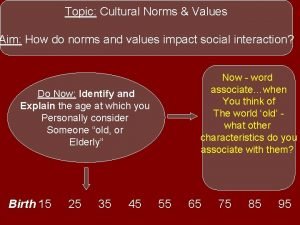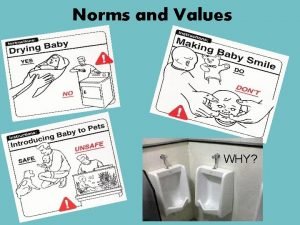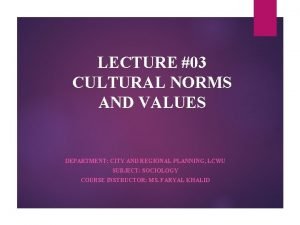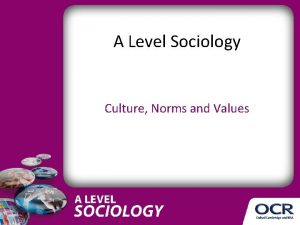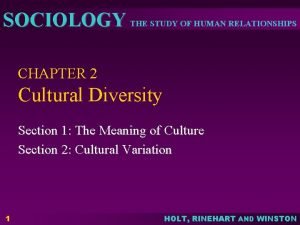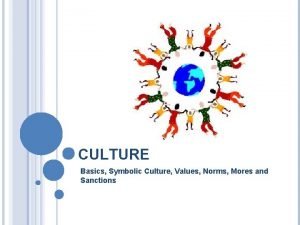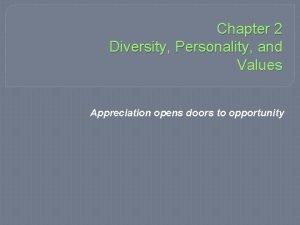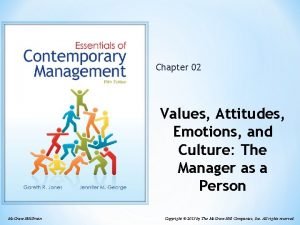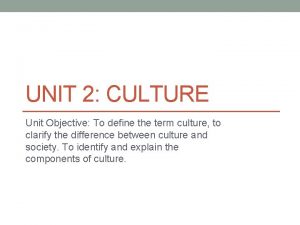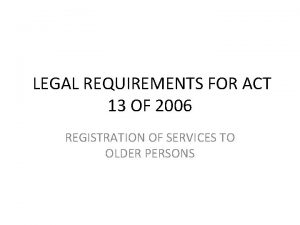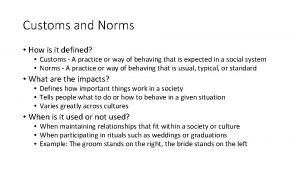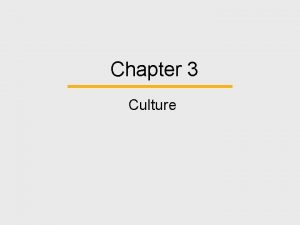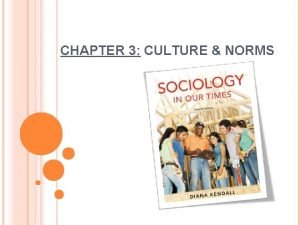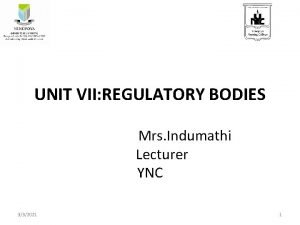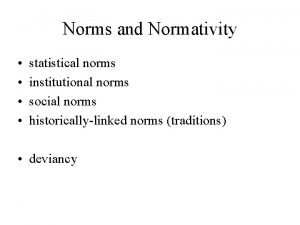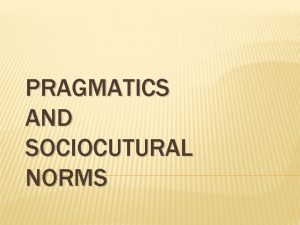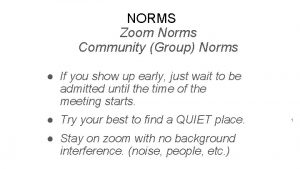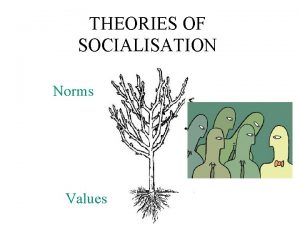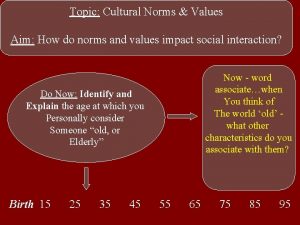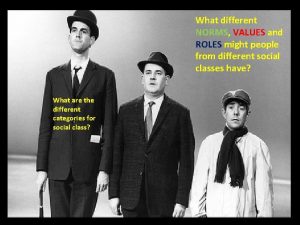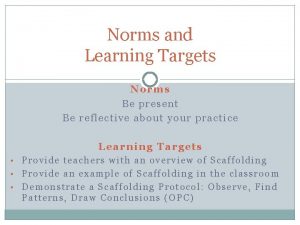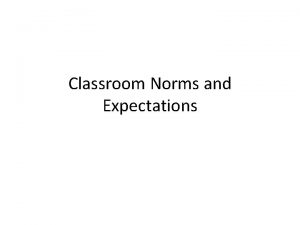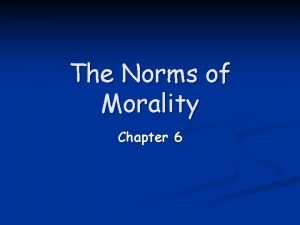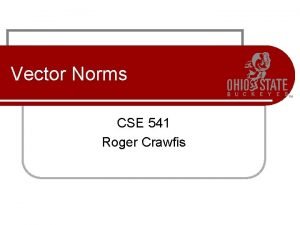Unit Three Values norms roles and status Values























- Slides: 23



Unit Three Values, norms, roles and status Values A value is a belief that something is good or valuable. It defines what is important, worthwhile, and worth striving for. For example, in modern Britain the value of individual achievement is highly regarded, while in many smaller-scale societies the importance of group solidarity is emphasized. Values imply that there are certain appropriate forms of actions that ought to be taken; for example, life is precious, therefore it is wrong to kill anybody.

Values change as times and circumstances alter. Norms. The word norm may cover many types of rules, including customs, conventions, social etiquette, morals and laws. The factor common to all of these is that social pressure in some form is exerted to increase the chances of conformity to the norm. some norms appear trivial, such as those about appropriate dress at theatre, or the correct use of cutlery at formal dinners. The common link between them is that a person who fails to obey them in the appropriate situation will meet with punishment, disapproval or even exclusion from the group.

Roles The values of the culture in which we live define the roles that we play and the pattern of behavior that goes with those roles. Roles can be defined as a set of normative expectations. We all play many roles in the course of our life, sometimes even in the same day. The relationships we form as a direct result of having a role are called a role set.

Status. The term status refers to the level of social honor or prestige given to someone by others, either as a result of the formal role they are playing in their social position, or for the individual skills and talents they display. Different occupations are associated with different levels of status, although differences of status also exist within an occupation- a status hierarchy. Some statuses are given to us or ascribed, such as mother, father, daughter or son. Others may be chosen, or achieved, such as employment roles- being a firefighter or a judge.

The status accorded a role is defined by the culture in which you live. The elderly as a status group, for example, carry a lower status in Western than other societies. In industrial societies, the primary stage of socialisation is further extended when children enter the education system. This is called secondary socialisation. At school they learn wider values of society outside their experience of the family, and are treated not as particular individuals but as members of a larger community.

The construction of social identities Socialisation is also important in shaping the particular identities that each person acquires during his/her lifetime. These identities are linked to the performance of particular roles, such as male/female, child/adult, member of a cultural or occupational group. Gender socialisation Gender roles are socialised into children in the family and reinforced at school. Gender role socialisation refers to the various ways in which a child learns to act in a manner which society regards as being appropriate to his or her sex.

Girls are presented as passive, caring and dependent: boys as aggressive, adventurous and independent. Ø 95 % of model cars/planes and train sets go to boys. Ø 85 % of dolls’ furniture goes to girls Ø 95 % of fire station sets go to boys.

Kessler and Mc. Kenna ( 1978 ) cited in A Level Sociology are ethnomethodologists who have investigated the way that scientists categorise the differences between males and females. They argue that there is no clearcut way of differentiating between men and women on the basis of biological ‘ facts’. Hermaphroditism is a condition where a person has both male and female genitals. There is the evidence of transsexuals who have the genitals associated with one sex but feel themselves to be members of the opposite sex.

Adolescence ( 12 – 18 years ) The word ‘ adolescence’ is used here to cover ages 12 to 18. 18 is the age when people are first allowed to vote and take on adult responsibilities. Adolescents become increasingly independent of their family, and friendship groups can become more important than family for the development of social skills. This phase of development is called secondary socialisation. The five years between 13 and 18 can involve major changes in social behaviour, as people learn to take on adult roles and adult independence. Some adolescents experience conflict with their parents during this period of change.

When they leave school socialisation continues as they prepare to enter adulthood and when they become parents the cycle begins all over again. Socialisation is a continuous, never-ending process. Activity 1. List the roles that you may play in any one day of your life.

Health and ageing OECD – international work on ageing http: // www. oecd. org/subject/ageing We live in an ageing society, in which the proportion of people who are sixty-five or over is steadily increasing. Gerontology, the study of ageing and the elderly, concerns itself not only with the physical process of growing old, but also with social and cultural factors connected to ageing.

Older people in modern societies tend to have lower status and less power than they used to have in pre modern cultures. In India or china , old age was believed to bring wisdom, and the oldest people in any given community were commonly its main decision-makers.

Old age ( 65 onwards) Most people retire by the age of 65 and the period of life after the age of 65 is Generally regarded as old age. Problems related to old age. v. The heart, breathing and circulation become weaker. v Muscles may become weaker and skin becomes less elastic. v Muscles, skin, joints and bones become less flexible and this can mean that people become less mobile, more at risk of fractured bones and more likely to develop wrinkled skin. v Most organs in the body, such as the liver and kidneys, work less efficiently.

v the risks of impairements and disability rise with increasing age. v reaction times and speed of thinking slow down. Life after 65 involves a general slowing down of physical activity.

Demographic statistics – some sociologists and gerontologists refer to the ‘ greying’ of the population. !850 in Britain – population over 65 years old = 5 %. Today the figure is over 15% and will continue to grow. One in every seven people in the developed world is aged over 65. In 30 years’ time this will have risen to one in four. The number of the ‘ old ‘ ( those aged over eighty-five ) – is expanding more quickly than the ‘ young old’. Over the next half-century, the number of people over eighty-five will grow sixfold. This process is sometimes referred to as the ‘ ageing of the aged’.

Intellectual development Some people seem to become less able to solve problems and cope with difficult, intellectual challenges in later life. The risk of developing dementia or Alzheimer’s Disease seems to increase with age; but dementia is not a part of normal ageing. v a loss of ability to control emotion v difficulty in understanding other people v difficulties in communicating and expressing thoughts v problems with daily living activities like getting dressed.

Social development Older people lead varied and different lives. Many retired people have a greater opportunity for meeting and making new friends than they did while they were working. Health , economic, poverty, social problems and impairments can sometimes create difficulties for older people, which might result in social isolation.

Social order and control Order and predictability are important if society is to exist. There must be rules and regulations that guide human behaviour if people are to engage in any form of social life. How could people cooperate in any joint venture if they lacked a common understanding of how they are expected to behave and what they aim to achieve?

Where people are interacting togethere is always the possibility that a misunderstanding or disagreement may occur that will transform an orderly process into a conflict-laden encounter. Conflict may occur in a marriage where the partners have different ideas about how they should behave within the relationship. Each partner would be putting forward his or her own view of the norms and values that should be followed ( the social order) if they are to have a harmonious, conflict-free marriage.

Social control – in order to persuade people to follow the normal ways of behaving, societies have developed two methods of ensuring conformity: informal and formal social control. The most common form of social control is informal and is based upon the socialization process. It is through the socialization process that people learn about the values of society and if this process has been successful conformity will follow automatically. Informal social control refers to the mechanisms that are used to reinforce socialization. It is based on rewards and encouragement for correct behavior and sanctions such as ridicule, gossip and comment for incorrect behavior.

The mass media exercise informal social control in a variety of ways. They may discourage people from behaving ‘ abnormally’, for example, by portraying such behaviour as deviant and unacceptable to the majority of the population. Formal control refers to the public, legal forms of controlling the population. Special agencies appointed for the purposes of social control include the police, the courts and the prisons. They catch, judge and punish anyone who breaks the law, and in the process they attempt to deter others from doing the same thing.
 Values vs norms
Values vs norms Examples of social norms
Examples of social norms Norms vs values examples
Norms vs values examples Norms and values in sociology
Norms and values in sociology Values and norms
Values and norms What is symbolic culture
What is symbolic culture Example of material culture
Example of material culture The role of marketing research
The role of marketing research What are the three levels of management
What are the three levels of management Terminal values and instrumental values
Terminal values and instrumental values An individual's enduring tendency to feel
An individual's enduring tendency to feel Unit 6 review questions
Unit 6 review questions Three gorges dam status
Three gorges dam status Folkways norms examples
Folkways norms examples Dq98 assessment form
Dq98 assessment form Customs and norms meaning
Customs and norms meaning Culture is symbolic
Culture is symbolic Norms in culture
Norms in culture Ohsc inspection tools
Ohsc inspection tools Raw score in psychology
Raw score in psychology Inc norms and guidelines slideshare
Inc norms and guidelines slideshare Plc norms
Plc norms Interpreting test scores and norms
Interpreting test scores and norms Strict norms that control moral and ethical behavior
Strict norms that control moral and ethical behavior
